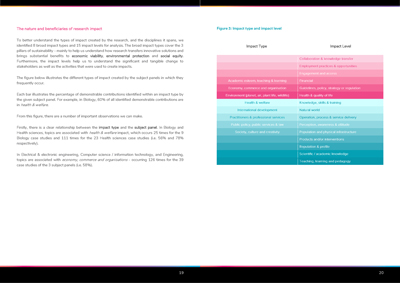Impact can take many different forms. At the simplest level, these impact types can cover social, environmental and economic issues. However, there are plenty of different varieties to consider during your activities – many of which require different types of evidence to support them.
Some typical examples of impact types and the corresponding evidence that can best represent your progress towards them can be seen below:
Health and wellbeing
- Reports on changes in Quality Of Life Years (QOLYs).
- Statistics reflecting changes to the number of admissions, presentations at hospital facilities over time.
- Patient surveys.
- Testimonials from clinical staff.
Commercial and economic
- Company reports, e.g. annual reports.
- Company websites.
- Licence agreements.
- Cost savings reports over time.
- National government statistics showing changes over time.
Public policy
- Policy documentation.
- Regulation and standards documentation.
- Public meeting minutes.
- Social media “shares” over time.
- Legal documentation.
- International non-governmental organisation policy briefings.
Societal and cultural
- Audience surveys.
- Testimonials from influential cultural figures.
- Media coverage statistics such as readership.
Environmental
- Government reports.
- Charity reports.
- Independent reports or reviews on improved functionality of machines.
How do I learn more about impact types and impact levels?
If you’d like to learn more about the different types of impact and evidence, please download our Collecting Research Impact Evidence eBook.
You can also engage with our eLearning courses around impact to help you develop understanding and expertise.
Furthermore, in 2022 hivve and partners in Hong Kong put together a report analysing research impact in Hong Kong.
A key component of the underpinning methodology was the impact types and impact levels, which detail useful clusters for analysing the 300+ Impact Case Studies in the report. Click to learn more:


